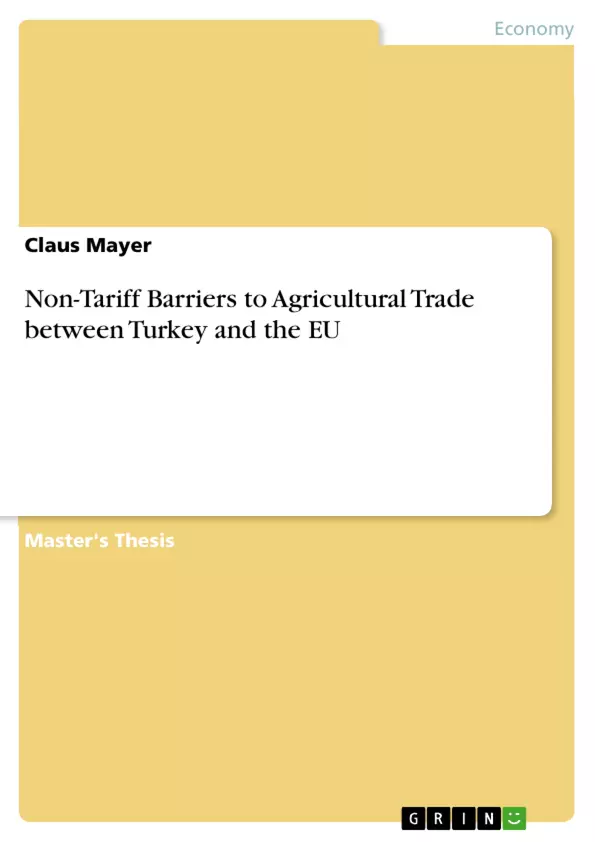This thesis reviews the border effect approach as an application of gravity models of trade and different methods of including multilateral resistance terms (MRTs) in it. Some focus is laid on the endogeneity problem of the approach. In an empirical application of the approach, agricultural trade between Turkey and the EU is analysed; the effect of data pooling and aggregation is studied; the conversion of estimated border effects into ad-valorem tariff equivalents (AVEs) reveals the crucial importance of a reliable measure of the elasticity of substitution when trying to separate the effects of NTBs of the total effect of a border.
Keywords: Non-tariff barriers to trade; gravity model; border effect approach; agricultural trade; EU; Turkey; ad-valorem tariff equivalents;
Inhaltsverzeichnis (Table of Contents)
- Introduction
- Why research Non-Tariff Barriers to Trade
- Structure of the Thesis
- Ways of capturing NTBs
- The Price Gap Method
- Price-based Econometric Methods
- Quantity-based Econometric Methods
- Simulations Methods
- The Gravity Equation in Physics and Economics
- The Border Effect Approach
- The Original Approach by McCallum
- Multilateral Resistance Terms
- Theoretical Derivation of the Gravity Equation
- Use of Price Index Data
- Use of estimated Border Effects
- Use of Fixed Effects
- The Trouble with Heteroskedasticity – Why OLS-Estimation of Log-linearised Models is problematic
- Jensen's Inequality and its Implications for Log-linearised Models
- CES Models and Heteroskedasticity
- Finding an Appropriate Estimator for the Non-Linear Model
- Maximum Likelihood Estimation and Poisson Regressions
- Application of the PPML Estimator in the Gravity Model
- The Problem of Endogeneity
- Non-Tariff Barriers to Agricultural Trade between Turkey and the EU: An Empirical Analysis
- Aim and Approach of Analysis
- Applied Gravity Model
- Data
- Estimation and Results
- Single sectors estimation using Importer-Exporter-Dummies
- Pooled and aggregated Regression using PPML
- Comparison of aggregated / pooled regression results with literature
- Calculation of AVES
- Concluding Remarks
Zielsetzung und Themenschwerpunkte (Objectives and Key Themes)
This thesis delves into the border effect approach within the context of gravity models of trade, specifically focusing on the challenges of incorporating multilateral resistance terms (MRTs) and addressing the endogeneity problem. The study uses the approach to analyze agricultural trade between Turkey and the EU, examining the impact of data aggregation and pooling. Through conversion of estimated border effects into ad-valorem tariff equivalents (AVES), the thesis highlights the importance of a reliable elasticity of substitution measure for distinguishing the effects of non-tariff barriers from the overall border impact.
- The border effect approach in gravity models of trade
- Incorporation of multilateral resistance terms (MRTs)
- Endogeneity problem in the border effect approach
- Analysis of agricultural trade between Turkey and the EU
- Impact of data aggregation and pooling on trade analysis
Zusammenfassung der Kapitel (Chapter Summaries)
The thesis begins with an introduction, emphasizing the significance of researching non-tariff barriers to trade and outlining the structure of the thesis. It then explores various methods for capturing non-tariff barriers, including price gap methods, price-based and quantity-based econometric methods, and simulation methods. The introduction also provides an overview of the gravity equation in physics and economics.
Chapter 2 delves into the border effect approach, starting with its original formulation by McCallum. It explores the inclusion of multilateral resistance terms and their derivation from the gravity equation, highlighting different approaches like using price index data, estimated border effects, and fixed effects. The chapter also addresses the issue of heteroskedasticity in log-linearized models and the challenges it poses for OLS estimation. It discusses the application of alternative estimators, including PPML, to address these challenges. Finally, the chapter examines the problem of endogeneity within the border effect approach.
Chapter 3 focuses on an empirical analysis of non-tariff barriers to agricultural trade between Turkey and the EU. It details the aim and approach of the analysis, the applied gravity model, and the data used. The chapter then presents the estimation and results, including single-sector estimation using importer-exporter dummies, pooled and aggregated regression using PPML, and a comparison of aggregated/pooled regression results with existing literature. The chapter concludes with a calculation of ad-valorem tariff equivalents (AVES).
Schlüsselwörter (Keywords)
The key topics and concepts explored in this thesis include non-tariff barriers to trade, gravity model, border effect approach, agricultural trade, European Union (EU), Turkey, ad-valorem tariff equivalents, data aggregation, data pooling, and endogeneity problem.
- Quote paper
- Claus Mayer (Author), 2012, Non-Tariff Barriers to Agricultural Trade between Turkey and the EU, Munich, GRIN Verlag, https://www.grin.com/document/208927



